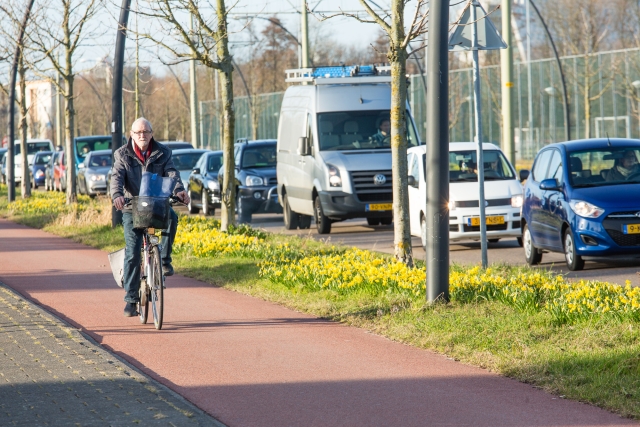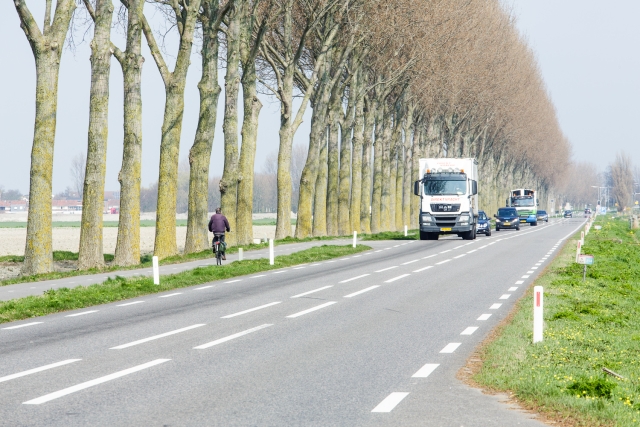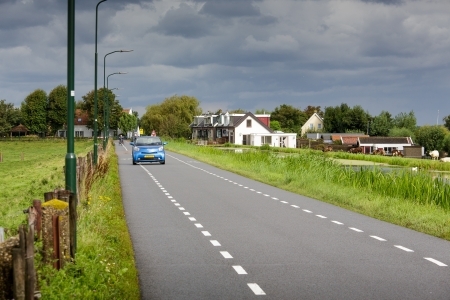Distributor roads connect access roads with through-roads. A distributor road facilitates both flow (on the road sections) and exchange of traffic (at the intersections) [5]. The driving speeds of motorised traffic are therefore higher than on access roads and, from a road safety perspective, cyclists need their own separate facilities (see SWOV fact sheet Infrastructure for pedestrians and cyclists). Exchange takes place at the intersections. This is where motorised traffic and cyclists and pedestrians meet and where the speed of motorised traffic must be lower than on the road sections. This can be done, for example, by means of a roundabout, raised intersection or speed bumps.
Mainly for capacity reasons, two road types are distinguished within the distributor road category [5]:
- road type I: dual carriageway, cross section with 2x2 lanes;
- road type II: single carriageway, cross section with 1x2 lanes.
Urban areas
Urban distributor roads usually have a 50 km/h speed limit, sometimes a 70 km/h limit. There are often separate facilities for cyclists and light moped riders. Preferably this is a physically separated bicycle track. Less safe, but also often applied, is a bicycle lane, separated from the lanes for motorised traffic by a (dis)continuous line. On road sections with a 50 km/h speed limit, moped riders generally use the carriageway, and on road sections with a 70km/h limit they use the bicycle/moped track.
Recently, a new type of distributor road has been proposed with a speed limit of 30km/h (see the question (zie de vraag Which road categories are distinguished in the Netherlands?). It is advisable to lower the speed limit to 30km/h for distributor roads where a separate bicycle track cannot be realised. In 2023, CROW intends to present recommendations for the design of 30km/h distributor roads.

Figure 3. Urban distributor road (Photo: Paul Voorham).
Rural areas
Distributor roads outside urban areas generally have an 80 km/h speed limit. On the road sections, the bicycle facilities are always physically separated. Mopeds must use the bicycle/moped track here. Because of the great speed differences, agricultural traffic should, in principle, not use the lanes of a distributor road, nor should it use the bicycle/moped track due to the large mass differences. However, this can often not be realised for lack of parallel roads or realistic alternative routes. Preferably, the driving directions are physically separated. In practice, however, many distributor roads outside urban areas have no physical driving direction separation, but a double centre line marking (preferably continuous, minimum variant guidelines) or even a single centre line marking (not in accordance with guidelines).

Figure 4. Rural distributor road, without physical separation of driving directions, with double centre lines (Photo: Paul Voorham).
Intersections
- In principle, intersections between two distributor roads are not grade separated and are preferably regulated by means of a roundabout (see SWOV fact sheet Roundabouts and other intersections). In some cases, for example when traffic volumes are high, a roundabout is not possible due to traffic flow concerns. Then traffic signals are necessary. Sometimes intersections are raised just in front of the signalised intersection to reduce speeds at the intersection to about 50 km/h [8].
- At intersections between a distributor road and an access road, the traffic on the distributor road has priority.
- An intersection between a distributor road and a through-road is in principle grade separated. It is important that the entry ramp to a motorway is clearly distinguishable from the exit, in order to prevent unintentional wrong-way driving (see also SWOV fact sheet Wrong-way driving). Sometimes an at-grade intersection is applied, usually controlled by traffic lights.
For more information about the design of distributor roads, see CROW publications [5] [9].
